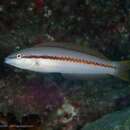Diagnostic Description
(
Inglês
)
fornecido por Fishbase
This specie sis distinguished by the following characters: D IX,11; A III,12; pectoral rays 13; caudal rays 14; lateral line scales 27; body y white with a stripe running on midline of the body from the snout, through the eye to tail; stripe straight, broadest and continuous from the snout to the shoulder, when it turns into a line of close-set spots in a zigzag pattern in alternate scales of 2 adjoining rows; terminal phase have the stripe entirely black or black at the first half becoming brownish, some with golden spots above and below scales, body darkened in the dorsum and the abdomen, becoming grayish or greenish in the area just above the mid-body stripe to the base of the dorsal fin; at the initial phase, the stripe is brown on the first third of its length and yellow to golden on the last two thirds (Ref. 80967).
- licença
- cc-by-nc
- direitos autorais
- FishBase
- Recorder
- Estelita Emily Capuli
Life Cycle
(
Inglês
)
fornecido por Fishbase
Distinct pairing during breeding (Ref. 205).
- licença
- cc-by-nc
- direitos autorais
- FishBase
Morphology
(
Inglês
)
fornecido por Fishbase
Dorsal spines (total): 9; Dorsal soft rays (total): 11; Analspines: 3; Analsoft rays: 12; Vertebrae: 24
- licença
- cc-by-nc
- direitos autorais
- FishBase
- Recorder
- Estelita Emily Capuli
Trophic Strategy
(
Inglês
)
fornecido por Fishbase
Mobile invertebrate feeder (Ref. 126840).
- licença
- cc-by-nc
- direitos autorais
- FishBase
- Recorder
- Patricia Sorongon-Yap
Biology
(
Inglês
)
fornecido por Fishbase
Maximum depth from Ref. 126840. This species was observed foraging solitary on sand bottoms immediately adjacent to the lower end of rocky reefs. Harems that are composed of a few (5-10) individuals are not common but occasionally seen. This fish sometimes venture over the reefs, but generally never shallower than 20 m depth depending on water temperature (they seem to be associated with temperatures lower than 18°C). It also forages mostly on mobile invertebrates on soft and hard substratum, being more commonly observed foraging on sand bottoms and this behavior makes it a potential nuclear species in following associations, as it has been observed in other species of Halichoeres (Ref. 80967).
- licença
- cc-by-nc
- direitos autorais
- FishBase
- Recorder
- Estelita Emily Capuli
Halichoeres sazimai
(
Inglês
)
fornecido por wikipedia EN
Halichoeres sazimai, Sazima's wrasse, is a species of fish in the family Labridae found in deeper (20m+) and cooler waters off southeastern Brazil. It's closely related to the north Atlantic species Halichoeres bathyphillus, but DNA evidence shows they are different.[1] They are often found in small groups of 5-10 individuals around rocky reefs.[2]
References

- licença
- cc-by-sa-3.0
- direitos autorais
- Wikipedia authors and editors
Halichoeres sazimai: Brief Summary
(
Inglês
)
fornecido por wikipedia EN
Halichoeres sazimai, Sazima's wrasse, is a species of fish in the family Labridae found in deeper (20m+) and cooler waters off southeastern Brazil. It's closely related to the north Atlantic species Halichoeres bathyphillus, but DNA evidence shows they are different. They are often found in small groups of 5-10 individuals around rocky reefs.
- licença
- cc-by-sa-3.0
- direitos autorais
- Wikipedia authors and editors

